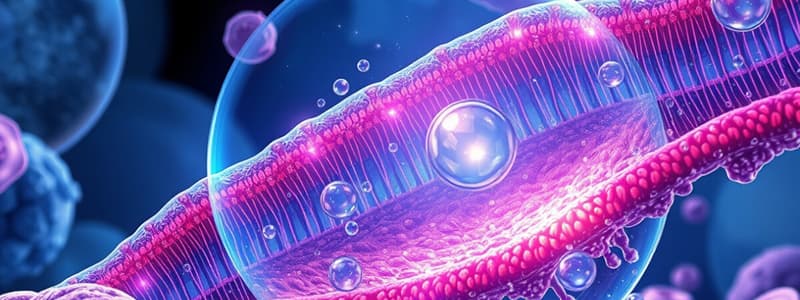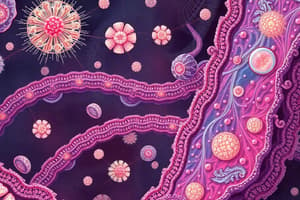Podcast
Questions and Answers
What is the primary function of the Na+-K+ pump?
What is the primary function of the Na+-K+ pump?
- To synthesize ATP from ADP
- To regulate cell volume and ion concentrations (correct)
- To convert glucose into energy
- To facilitate the diffusion of glucose
How does the Na+-K+ pump affect water movement within the cell?
How does the Na+-K+ pump affect water movement within the cell?
- It prevents any water movement across the membrane
- It creates an osmotic force that moves water out of the cell (correct)
- It increases water intake by drawing it into the cell
- It allows water to flow freely in and out of the cell
What is produced as a result of ATP cleavage by the ATPase function?
What is produced as a result of ATP cleavage by the ATPase function?
- Two molecules of high-energy phosphate
- Adenosine diphosphate and a high-energy phosphate bond (correct)
- Sodium ions and potassium ions
- Adenosine triphosphate and energy
What initiates the activation of the Na+-K+ pump when a cell begins to swell?
What initiates the activation of the Na+-K+ pump when a cell begins to swell?
Which statement accurately describes co-transport?
Which statement accurately describes co-transport?
What happens to the rate of transport at high concentrations of the substance being transported?
What happens to the rate of transport at high concentrations of the substance being transported?
What is the result of the Na+-K+ pump transporting three sodium ions for every two potassium ions?
What is the result of the Na+-K+ pump transporting three sodium ions for every two potassium ions?
Counter-transport and co-transport are both forms of what type of transport?
Counter-transport and co-transport are both forms of what type of transport?
What happens to a cell when there is a concentration difference of water across its membrane?
What happens to a cell when there is a concentration difference of water across its membrane?
What does osmotic pressure depend on in a solution?
What does osmotic pressure depend on in a solution?
Which statement about osmolality is correct?
Which statement about osmolality is correct?
How many grams of glucose are equivalent to 1 osmole?
How many grams of glucose are equivalent to 1 osmole?
Which process is described as moving a substance against an electrochemical gradient?
Which process is described as moving a substance against an electrochemical gradient?
What is the osmotic pressure of normal extracellular and intracellular fluids?
What is the osmotic pressure of normal extracellular and intracellular fluids?
What is the relationship between osmotic pressure and particle size?
What is the relationship between osmotic pressure and particle size?
What is meant by the term 'osmole'?
What is meant by the term 'osmole'?
What happens during sodium co-transport of glucose and amino acids?
What happens during sodium co-transport of glucose and amino acids?
What is required for the conformational change in transport proteins during sodium co-transport?
What is required for the conformational change in transport proteins during sodium co-transport?
In the sodium counter-transport mechanism, what is the movement of calcium ions?
In the sodium counter-transport mechanism, what is the movement of calcium ions?
Where does hydrogen ion counter-transport primarily occur?
Where does hydrogen ion counter-transport primarily occur?
What type of cells are considered 'excitable'?
What type of cells are considered 'excitable'?
What is primarily determined by the concentration gradient of sodium ions?
What is primarily determined by the concentration gradient of sodium ions?
What occurs when a sodium ion moves into a cell during counter-transport?
What occurs when a sodium ion moves into a cell during counter-transport?
What characterizes the membrane potentials of nerve and muscle cells?
What characterizes the membrane potentials of nerve and muscle cells?
What is the primary ion responsible for causing depolarization during an action potential?
What is the primary ion responsible for causing depolarization during an action potential?
What must occur for an action potential to be initiated?
What must occur for an action potential to be initiated?
During which period can an action potential not be elicited regardless of the stimulus strength?
During which period can an action potential not be elicited regardless of the stimulus strength?
What is the threshold membrane potential that must be reached for an action potential to occur?
What is the threshold membrane potential that must be reached for an action potential to occur?
Which of the following statements is true regarding the inactivation of sodium channels?
Which of the following statements is true regarding the inactivation of sodium channels?
How many impulses can be transmitted per second in large myelinated nerve fibers?
How many impulses can be transmitted per second in large myelinated nerve fibers?
What occurs during the relative refractory period?
What occurs during the relative refractory period?
What occurs during the positive-feedback mechanism of action potential generation?
What occurs during the positive-feedback mechanism of action potential generation?
What is the primary function of voltage-gated sodium channels during an action potential?
What is the primary function of voltage-gated sodium channels during an action potential?
What factor contributes to the greater leakage of potassium ions compared to sodium ions during the resting state?
What factor contributes to the greater leakage of potassium ions compared to sodium ions during the resting state?
How does the activation of voltage-gated sodium channels affect sodium permeability during an action potential?
How does the activation of voltage-gated sodium channels affect sodium permeability during an action potential?
What role do voltage-gated potassium channels play during the action potential?
What role do voltage-gated potassium channels play during the action potential?
What is the effect of rising membrane potential on voltage-gated sodium channels?
What is the effect of rising membrane potential on voltage-gated sodium channels?
What happens to the voltage-gated sodium channels shortly after they are activated?
What happens to the voltage-gated sodium channels shortly after they are activated?
What is the primary reason for the negative resting membrane potential before the action potential begins?
What is the primary reason for the negative resting membrane potential before the action potential begins?
What triggers the beginning of the action potential?
What triggers the beginning of the action potential?
Flashcards are hidden until you start studying
Study Notes
Water Movement and Osmotic Pressure
- Under normal conditions, water molecules diffuse equally in both directions across a cell membrane, resulting in no net movement and constant cell volume.
- A concentration difference for water can develop, causing net movement and potential cell swelling or shrinking.
- Osmotic pressure, the pressure required to stop osmosis, depends on particle concentration per unit volume rather than mass.
- The osmole quantifies concentration based on the number of particles: 1 osmole equals 1 gram molecular weight of undissociated solute.
- 180 grams of glucose represents 1 osmole, as glucose does not dissociate when dissolved.
- A solution with 1 osmole of solute per kilogram of water has an osmolality of 1 osmol/kg; 1/1000 osmole per kilogram is 1 milliosmole/kg.
- Normal osmolality for intracellular and extracellular fluids is about 300 milliosmoles/kg, with osmotic pressure around 5500 mm Hg.
Active Transport Mechanisms
- Active transport can move substances against their electrochemical gradient using energy, typically from ATP.
- The Na+-K+ pump transports three sodium ions outside the cell for every two potassium ions moved inside, contributing to osmotic forces that regulate cell volume.
- If a cell swells, the Na+-K+ pump is activated to extrude additional ions and water, maintaining balance.
- Active transport mechanisms can saturate like facilitated diffusion, limited by binding/release reactions and carrier conformation.
Co-Transport and Counter-Transport
- Co-transport allows sodium ions' passive diffusion to drive the active transport of other substances into the cell.
- Counter-transport moves sodium ions into the cell while expelling calcium or hydrogen ions using the same transport protein.
- Glucose and amino acids can enter most cells via sodium co-transport, requiring both sodium and the nutrient to bind to the transporter.
Membrane Potentials and Action Potentials
- All cell membranes, especially in excitable cells like nerves and muscles, maintain electrical potentials across them.
- Potassium ions' rapid diffusion reestablishes the negative resting membrane potential after action potentials.
- Voltage-gated sodium and potassium channels are critical for the progression of action potentials, affecting depolarization and repolarization phases.
- Initially, potassium conductance is much greater than sodium, but during action potentials, sodium conductance surges.
- Voltage-gated sodium channels open rapidly with an increase in membrane potential, facilitating high sodium ion influx—a positive-feedback cycle that continues until channels become inactivated.
Threshold and Refractory Periods
- An action potential only occurs when the threshold potential (approx. -65 mV) is reached, marked by more sodium ions entering than potassium exiting.
- During the absolute refractory period, no new action potential is possible even with strong stimuli, lasting about 1/2500 seconds in large myelinated fibers.
- Following the absolute refractory period, a relative refractory period occurs where stronger stimuli are required to elicit a new action potential.
Studying That Suits You
Use AI to generate personalized quizzes and flashcards to suit your learning preferences.




